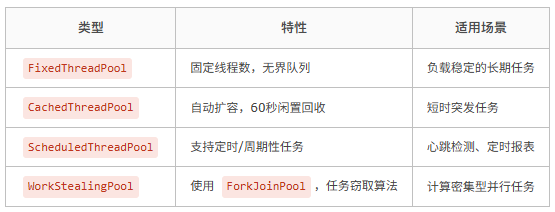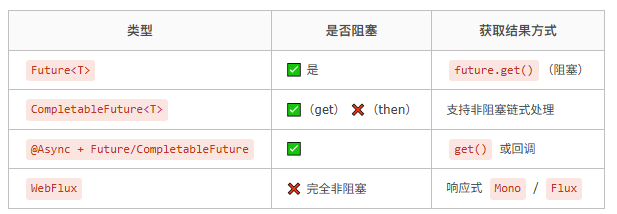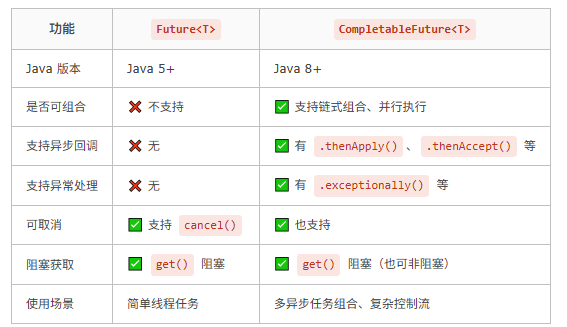简介
Java 异步编程是现代高性能应用开发的核心技术之一,它允许程序在执行耗时操作(如网络请求、文件 IO)时不必阻塞主线程,从而提高系统吞吐量和响应性。
异步 vs 同步
public String syncTask() { // 模拟耗时操作 Thread.sleep(1000); return "Result";}
复制代码
public CompletableFuture<String> asyncTask() { return CompletableFuture.supplyAsync(() -> { try { Thread.sleep(1000); } catch (InterruptedException e) { throw new RuntimeException(e); } return "Result"; });}
复制代码
Java 原生异步支持
手动创建线程
最基本的异步方式是创建 Thread 或实现 Runnable。
public class BasicAsync { public static void main(String[] args) { Thread thread = new Thread(() -> { try { Thread.sleep(1000); System.out.println("Task completed"); } catch (InterruptedException e) { e.printStackTrace(); } }); thread.start(); System.out.println("Main thread continues"); }}
复制代码
使用 ExecutorService
import java.util.concurrent.ExecutorService;import java.util.concurrent.Executors;
public class ThreadPoolExample { public static void main(String[] args) { ExecutorService executor = Executors.newFixedThreadPool(2); executor.submit(() -> { Thread.sleep(1000); System.out.println("Task 1 completed"); }); executor.submit(() -> { Thread.sleep(500); System.out.println("Task 2 completed"); }); executor.shutdown(); }}
复制代码
常用方法:
线程池类型:
Executors.newFixedThreadPool(n):固定大小线程池。
Executors.newCachedThreadPool():动态调整线程数。
Executors.newSingleThreadExecutor():单线程执行。
线程池类型对比:
Future(Java 5+)
import java.util.concurrent.*;
public class FutureExample { public static void main(String[] args) throws Exception { ExecutorService executor = Executors.newFixedThreadPool(1); Future<String> future = executor.submit(() -> { Thread.sleep(1000); return "Task completed"; });
// 主线程继续 System.out.println("Doing other work");
// 阻塞获取结果 String result = future.get(); // 等待任务完成 System.out.println(result);
executor.shutdown(); }}
复制代码
方法
get():阻塞获取结果。
isDone():检查任务是否完成。
cancel(boolean):取消任务。
缺点
get() 是阻塞的,不利于非阻塞编程。
难以组合多个异步任务。
CompletableFuture(Java 8+)
支持链式调用,真正现代化异步编程方式。
import java.util.concurrent.CompletableFuture;
public class CompletableFutureExample { public static void main(String[] args) { CompletableFuture.supplyAsync(() -> { try { Thread.sleep(1000); } catch (InterruptedException e) { throw new RuntimeException(e); } return "Task result"; }) .thenApply(result -> result.toUpperCase()) // 转换结果 .thenAccept(result -> System.out.println(result)) // 消费结果 .exceptionally(throwable -> { System.err.println("Error: " + throwable.getMessage()); return null; });
System.out.println("Main thread continues"); }}
复制代码
虚拟线程(Java 21+,Project Loom)
虚拟线程是 Java 21 引入的轻量级线程,适合高并发 I/O 密集型任务。
public class VirtualThreadExample { public static void main(String[] args) { try (var executor = Executors.newVirtualThreadPerTaskExecutor()) { executor.submit(() -> { try { Thread.sleep(1000); System.out.println("Task completed in virtual thread"); } catch (InterruptedException e) { e.printStackTrace(); } }); } System.out.println("Main thread continues"); }}
复制代码
优势
注意
阻塞 vs 非阻塞
Future<T> vs CompletableFuture<T>:核心对比
Spring 异步编程(基于 @Async)
配置类或启动类启用异步支持
@SpringBootApplication@EnableAsyncpublic class Application { public static void main(String[] args) { SpringApplication.run(Application.class, args); }}
复制代码
@Configuration@EnableAsyncpublic class AsyncConfig {}
复制代码
无返回值用法
// 无返回值的异步方法@Asyncpublic void sendEmail(String to) { System.out.println("异步发送邮件给: " + to); try { Thread.sleep(2000); } catch (InterruptedException e) {} System.out.println("邮件发送完成");}
复制代码
使用 Future<T>
创建异步方法
@Servicepublic class AsyncService { @Async public Future<String> processTask() { // 模拟耗时操作 return new AsyncResult<>("Task completed"); }}
复制代码
调用并获取结果:
@Autowiredprivate AsyncService asyncService;
public void executeTask() throws Exception { Future<String> future = asyncService.processTask(); String result = future.get(); // 阻塞等待结果}
复制代码
使用 CompletableFuture<T>
创建异步方法
@Asyncpublic CompletableFuture<String> asyncMethod() { return CompletableFuture.completedFuture("Async Result");}
复制代码
调用方式:
CompletableFuture<String> result = asyncService.asyncMethod();// 非阻塞,可以做其他事String value = result.get(); // 阻塞获取
复制代码
线程池配置
使用自定义配置类
@Configurationpublic class AsyncConfig {
@Bean("taskExecutor") public Executor taskExecutor() { ThreadPoolTaskExecutor executor = new ThreadPoolTaskExecutor(); executor.setCorePoolSize(5); // 核心线程数 executor.setMaxPoolSize(20); // 最大线程数 executor.setQueueCapacity(100); // 队列容量 executor.setKeepAliveSeconds(30); // 空闲线程存活时间 executor.setThreadNamePrefix("async-task-"); executor.setRejectedExecutionHandler(new ThreadPoolExecutor.CallerRunsPolicy()); executor.initialize(); return executor; }}
// 指定线程池@Async("taskExecutor")public Future<String> customPoolTask() { ... }
复制代码
使用配置文件
# application.ymlspring: task: execution: pool: core-size: 5 max-size: 20 queue-capacity: 100 thread-name-prefix: async- shutdown: await-termination: true terminate-on-timeout: true
复制代码
Spring WebFlux 示例
@Servicepublic class UserService { public Mono<String> getUser() { return Mono.just("用户信息").delayElement(Duration.ofSeconds(2)); }
public Flux<String> getAllUsers() { return Flux.just("用户1", "用户2", "用户3").delayElements(Duration.ofSeconds(1)); }}
复制代码
@RestController@RequestMapping("/users")public class UserController {
@Autowired private UserService userService;
@GetMapping("/one") public Mono<String> getUser() { return userService.getUser(); }
@GetMapping("/all") public Flux<String> getAllUsers() { return userService.getAllUsers(); }}
复制代码
调用时非阻塞行为体现
SpringBoot 集成示例
@Async 标记方法为异步执行,Spring 在线程池中运行该方法。
import org.springframework.scheduling.annotation.Async;import org.springframework.stereotype.Service;
@Servicepublic class AsyncService { @Async public CompletableFuture<String> doAsyncTask() { try { Thread.sleep(1000); } catch (InterruptedException e) { throw new RuntimeException(e); } return CompletableFuture.completedFuture("Task completed"); }}
复制代码
在主类或配置类上添加 @EnableAsync。
@SpringBootApplication@EnableAsyncpublic class Application { public static void main(String[] args) { SpringApplication.run(Application.class, args); }}
复制代码
@RestControllerpublic class AsyncController { @Autowired private AsyncService asyncService;
@GetMapping("/async") public String triggerAsync() { asyncService.doAsyncTask().thenAccept(result -> System.out.println(result)); return "Task triggered"; }}
复制代码
Spring 默认使用 SimpleAsyncTaskExecutor,不适合生产环境。推荐配置自定义线程池。
import org.springframework.context.annotation.Bean;import org.springframework.context.annotation.Configuration;import org.springframework.scheduling.concurrent.ThreadPoolTaskExecutor;
@Configurationpublic class AsyncConfig { @Bean(name = "taskExecutor") public ThreadPoolTaskExecutor taskExecutor() { ThreadPoolTaskExecutor executor = new ThreadPoolTaskExecutor(); executor.setCorePoolSize(2); executor.setMaxPoolSize(10); executor.setQueueCapacity(25); executor.setThreadNamePrefix("AsyncThread-"); executor.initialize(); return executor; }}
复制代码
@Async("taskExecutor")public CompletableFuture<String> doAsyncTask() { // 异步逻辑}
复制代码
@Componentpublic class AsyncExceptionHandler implements AsyncUncaughtExceptionHandler { @Override public void handleUncaughtException(Throwable ex, Method method, Object... params) { System.err.println("Async error: " + ex.getMessage()); }}
复制代码
并行调用多个服务示例
并行调用 getUser 和 getProfile,总耗时接近较慢的任务(~1s)。
@Servicepublic class UserService { @Async public CompletableFuture<User> getUser(Long id) { return CompletableFuture.supplyAsync(() -> { // 模拟远程调用 try { Thread.sleep(1000); } catch (InterruptedException e) { throw new RuntimeException(e); } return new User(id, "User" + id); }); }
@Async public CompletableFuture<Profile> getProfile(Long id) { return CompletableFuture.supplyAsync(() -> { try { Thread.sleep(500); } catch (InterruptedException e) { throw new RuntimeException(e); } return new Profile(id, "Profile" + id); }); }}
@RestControllerpublic class UserController { @Autowired private UserService userService;
@GetMapping("/user/{id}") public CompletableFuture<UserProfile> getUserProfile(@PathVariable Long id) { return userService.getUser(id) .thenCombine(userService.getProfile(id), (user, profile) -> new UserProfile(user, profile)); }}
复制代码
异步批量处理示例
并行处理 10 个任务,显著减少总耗时。
@Servicepublic class BatchService { @Async public CompletableFuture<Void> processItem(int item) { return CompletableFuture.runAsync(() -> { try { Thread.sleep(100); System.out.println("Processed item: " + item); } catch (InterruptedException e) { throw new RuntimeException(e); } }); }}
@RestControllerpublic class BatchController { @Autowired private BatchService batchService;
@PostMapping("/batch") public CompletableFuture<Void> processBatch() { List<CompletableFuture<Void>> futures = new ArrayList<>(); for (int i = 1; i <= 10; i++) { futures.add(batchService.processItem(i)); } return CompletableFuture.allOf(futures.toArray(new CompletableFuture[0])); }}
复制代码
响应式 WebFlux 示例
@Servicepublic class ReactiveService { public Mono<String> fetchData() { return Mono.just("Data") .delayElement(Duration.ofSeconds(1)); }}
@RestControllerpublic class ReactiveController { @Autowired private ReactiveService reactiveService;
@GetMapping("/data") public Mono<String> getData() { return reactiveService.fetchData(); }}
复制代码
Spring Data JPA 集成示例
JPA 默认阻塞操作,可通过 @Async 包装异步调用。
@Repositorypublic interface UserRepository extends JpaRepository<User, Long> {}
@Servicepublic class UserService { @Autowired private UserRepository userRepository;
@Async public CompletableFuture<User> findUser(Long id) { return CompletableFuture.supplyAsync(() -> userRepository.findById(id).orElse(null)); }}
复制代码
MyBatis Plus 集成示例
MyBatis Plus 默认阻塞,可通过 @Async 或线程池异步化。
@Mapperpublic interface UserMapper extends BaseMapper<User> {}
@Servicepublic class UserService { @Autowired private UserMapper userMapper;
@Async public CompletableFuture<User> getUser(Long id) { return CompletableFuture.supplyAsync(() -> userMapper.selectById(id)); }}
复制代码
注意事项
CompletableFuture 所有核心 API
CompletableFuture<T> 用法详解
创建异步任务
supplyAsync:基本异步任务执行
CompletableFuture<String> cf = CompletableFuture.supplyAsync(() -> "Result");
复制代码
runAsync:异步执行任务,无返回值
CompletableFuture<Void> cf = CompletableFuture.runAsync(() -> System.out.println("Async run"));
复制代码
任务转换
thenApply(Function):转换结果,对结果加工
CompletableFuture<String> future = CompletableFuture .supplyAsync(() -> "data") .thenApply(data -> data.toUpperCase());
System.out.println(future.get()); // DATA
复制代码
thenCompose(Function):扁平化链式异步
CompletableFuture<String> composed = CompletableFuture .supplyAsync(() -> "A") .thenCompose(a -> CompletableFuture.supplyAsync(() -> a + "B"));
composed.thenAccept(System.out::println); // 输出 AB
复制代码
thenCombine(CompletionStage, BiFunction):两个任务完成后合并结果
CompletableFuture<String> cf1 = CompletableFuture.supplyAsync(() -> "Hello");CompletableFuture<String> cf2 = CompletableFuture.supplyAsync(() -> "World");
cf1.thenCombine(cf2, (a, b) -> a + " " + b).thenAccept(System.out::println);
复制代码
CompletableFuture<String> f1 = CompletableFuture.supplyAsync(() -> "A");CompletableFuture<String> f2 = CompletableFuture.supplyAsync(() -> "B");
CompletableFuture<String> result = f1.thenCombine(f2, (a, b) -> a + b);System.out.println(result.get()); // AB
复制代码
消费结果
thenAccept(Consumer):消费结果
CompletableFuture .supplyAsync(() -> "Result") .thenAccept(result -> System.out.println("Received: " + result));
复制代码
thenRun(Runnable):继续执行下一个任务,无需前面结果
CompletableFuture .supplyAsync(() -> "X") .thenRun(() -> System.out.println("Next step executed"));
复制代码
异常处理
exceptionally(Function<Throwable, T>):异常处理
CompletableFuture<String> future = CompletableFuture.supplyAsync(() -> { if (true) throw new RuntimeException("Oops!"); return "ok";}).exceptionally(ex -> "Fallback: " + ex.getMessage());
System.out.println(future.get());
复制代码
handle(BiFunction<T, Throwable, R>):同时处理正常与异常结果
CompletableFuture<String> future = CompletableFuture.supplyAsync(() -> { throw new RuntimeException("Error!");}).handle((result, ex) -> { if (ex != null) return "Handled: " + ex.getMessage(); return result;});
System.out.println(future.get());
复制代码
whenComplete(BiConsumer<T, Throwable>):类似 finally
CompletableFuture<String> future = CompletableFuture.supplyAsync(() -> "Final Result") .whenComplete((result, ex) -> { System.out.println("Completed with: " + result); });
复制代码
CompletableFuture<String> future = CompletableFuture.supplyAsync(() -> { if (true) throw new RuntimeException("出错了"); return "成功";}).whenComplete((result, exception) -> { if (exception != null) { System.out.println("发生异常:" + exception.getMessage()); } else { System.out.println("执行结果:" + result); }});
复制代码
并发组合
allOf / anyOf:组合任务
CompletableFuture<Void> all = CompletableFuture.allOf(task1, task2);CompletableFuture<Object> any = CompletableFuture.anyOf(task1, task2);
复制代码
allOf(...):等待全部任务完成
需要单独从每个任务中再 .get() 拿到结果
CompletableFuture<String> f1 = CompletableFuture.supplyAsync(() -> "A");CompletableFuture<String> f2 = CompletableFuture.supplyAsync(() -> "B");
CompletableFuture<Void> all = CompletableFuture.allOf(f1, f2);all.thenRun(() -> System.out.println("All done")).get();
复制代码
CompletableFuture<String> userFuture = CompletableFuture.supplyAsync(() -> fetchUser());CompletableFuture<String> orderFuture = CompletableFuture.supplyAsync(() -> fetchOrder());
// 两个任务都完成后执行CompletableFuture<Void> bothDone = CompletableFuture.allOf(userFuture, orderFuture);
bothDone.thenRun(() -> { try { String user = userFuture.get(); String order = orderFuture.get(); System.out.println("用户: " + user + ", 订单: " + order); } catch (Exception e) { e.printStackTrace(); }});
复制代码
anyOf(...):任一完成即触发
CompletableFuture<String> f1 = CompletableFuture.supplyAsync(() -> { try { Thread.sleep(1000); } catch (InterruptedException e) {} return "fast";});CompletableFuture<String> f2 = CompletableFuture.supplyAsync(() -> "slow");
CompletableFuture<Object> any = CompletableFuture.anyOf(f1, f2);System.out.println(any.get()); // 输出最快那个
复制代码
超时控制
orTimeout(long timeout, TimeUnit unit):超时异常
如果在指定时间内没有完成,就抛出 TimeoutException 异常。
CompletableFuture<String> f = CompletableFuture.supplyAsync(() -> { try { Thread.sleep(2000); } catch (Exception e) {} return "late result";}).orTimeout(1, TimeUnit.SECONDS);
try { System.out.println(f.get());} catch (Exception e) { System.out.println("Timeout: " + e.getMessage());}
复制代码
CompletableFuture<String> future = CompletableFuture.supplyAsync(() -> { try { Thread.sleep(3000); } catch (InterruptedException e) { e.printStackTrace(); } return "执行完成";}).orTimeout(2, TimeUnit.SECONDS) .exceptionally(ex -> "捕获到异常:" + ex.getClass().getSimpleName());
System.out.println("结果:" + future.join()); // 打印“捕获到异常:TimeoutException”
复制代码
completeOnTimeout(T value, long timeout, TimeUnit unit):超时默认值
如果在指定时间内没有完成,则返回一个默认值,并完成该任务。
CompletableFuture<String> f = CompletableFuture.supplyAsync(() -> { try { Thread.sleep(2000); } catch (Exception e) {} return "slow";}).completeOnTimeout("timeout default", 1, TimeUnit.SECONDS);
System.out.println(f.get()); // timeout default
复制代码
CompletableFuture<String> future = CompletableFuture.supplyAsync(() -> { try { Thread.sleep(3000); // 模拟耗时任务 } catch (InterruptedException e) { e.printStackTrace(); } return "正常返回结果";}).completeOnTimeout("超时默认值", 2, TimeUnit.SECONDS);
System.out.println("最终结果:" + future.join()); // 会打印“超时默认值”
复制代码
自定义线程池
ExecutorService pool = Executors.newFixedThreadPool(2);
CompletableFuture<String> f = CompletableFuture.supplyAsync(() -> "pooled", pool);System.out.println(f.get());pool.shutdown();
复制代码
异步任务 + 消费结果
CompletableFuture<Void> future = CompletableFuture .supplyAsync(() -> "hello") .thenAccept(result -> System.out.println("结果是:" + result));
复制代码
异步任务 + 转换结果(链式调用)
CompletableFuture<String> future = CompletableFuture .supplyAsync(() -> "5") .thenApply(Integer::parseInt) .thenApply(num -> num * 2) .thenApply(Object::toString);
复制代码
异常处理
CompletableFuture<String> future = CompletableFuture .supplyAsync(() -> { if (true) throw new RuntimeException("出错了!"); return "success"; }) .exceptionally(ex -> { System.out.println("异常: " + ex.getMessage()); return "默认值"; });
复制代码
多任务并发组合(allOf / anyOf)
CompletableFuture<String> f1 = CompletableFuture.supplyAsync(() -> "A");CompletableFuture<String> f2 = CompletableFuture.supplyAsync(() -> "B");
// 等待全部完成CompletableFuture<Void> all = CompletableFuture.allOf(f1, f2);all.join();
System.out.println("结果:" + f1.join() + ", " + f2.join());
复制代码
合并两个任务结果
CompletableFuture<Integer> f1 = CompletableFuture.supplyAsync(() -> 100);CompletableFuture<Integer> f2 = CompletableFuture.supplyAsync(() -> 200);
CompletableFuture<Integer> result = f1.thenCombine(f2, Integer::sum);System.out.println(result.get()); // 输出 300
复制代码
自定义线程池
ExecutorService pool = Executors.newFixedThreadPool(4);
CompletableFuture<String> future = CompletableFuture.supplyAsync(() -> { return "线程池中的任务";}, pool);
System.out.println(future.get());pool.shutdown();
复制代码
链式异步处理
CompletableFuture.supplyAsync(() -> "Step 1") .thenApply(s -> s + " -> Step 2") .thenCompose(s -> CompletableFuture.supplyAsync(() -> s + " -> Step 3")) .thenAccept(System.out::println) .exceptionally(ex -> { ex.printStackTrace(); return null; });
复制代码
订单处理示例
public class OrderSystem { @Async("dbExecutor") public CompletableFuture<Order> saveOrder(Order order) { // 数据库写入操作 return CompletableFuture.completedFuture(order); }
@Async("httpExecutor") public CompletableFuture<String> notifyLogistics(Order order) { // 调用物流API return CompletableFuture.completedFuture("SUCCESS"); }
public void processOrder(Order order) { CompletableFuture<Order> saveFuture = saveOrder(order); saveFuture.thenCompose(savedOrder -> notifyLogistics(savedOrder) ).exceptionally(ex -> { log.error("物流通知失败", ex); return "FALLBACK"; }); }}
复制代码
总结图谱
CompletableFuture├─ 创建任务│ ├─ runAsync() -> 无返回值│ └─ supplyAsync() -> 有返回值├─ 处理结果│ ├─ thenApply() -> 转换│ ├─ thenAccept() -> 消费│ ├─ thenRun() -> 执行新任务│ ├─ thenCombine() -> 合并结果│ └─ thenCompose() -> 链式调用├─ 异常处理│ ├─ exceptionally()│ ├─ handle()│ └─ whenComplete()├─ 组合任务│ ├─ allOf()│ └─ anyOf()└─ 超时控制 ├─ orTimeout() └─ completeOnTimeout()
复制代码
什么场景适合用 Java 异步(@Async / CompletableFuture)?
Java 和 .NET 异步处理对比
并行调用两个服务,提高响应速度
Spring Boot 示例(@Async + CompletableFuture)
项目结构
└── src └── main ├── java │ ├── demo │ │ ├── controller │ │ │ └── AggregateController.java │ │ ├── service │ │ │ ├── RemoteService.java │ │ │ └── RemoteServiceImpl.java │ │ └── DemoApplication.java
复制代码
RemoteService.java
public interface RemoteService { @Async CompletableFuture<String> getUserInfo();
@Async CompletableFuture<String> getAccountInfo();}
复制代码
RemoteServiceImpl.java
@Servicepublic class RemoteServiceImpl implements RemoteService {
@Override public CompletableFuture<String> getUserInfo() { try { Thread.sleep(2000); // 模拟耗时 } catch (InterruptedException e) { throw new RuntimeException(e); } return CompletableFuture.completedFuture("UserInfo"); }
@Override public CompletableFuture<String> getAccountInfo() { try { Thread.sleep(3000); // 模拟耗时 } catch (InterruptedException e) { throw new RuntimeException(e); } return CompletableFuture.completedFuture("AccountInfo"); }}
复制代码
AggregateController.java
@RestController@RequestMapping("/api")public class AggregateController {
@Autowired private RemoteService remoteService;
@GetMapping("/aggregate") public ResponseEntity<String> aggregate() throws Exception { CompletableFuture<String> userFuture = remoteService.getUserInfo(); CompletableFuture<String> accountFuture = remoteService.getAccountInfo();
// 等待所有完成 CompletableFuture.allOf(userFuture, accountFuture).join();
// 获取结果 String result = userFuture.get() + " + " + accountFuture.get(); return ResponseEntity.ok(result); }}
复制代码
DemoApplication.java
@SpringBootApplication@EnableAsyncpublic class DemoApplication { public static void main(String[] args) { SpringApplication.run(DemoApplication.class, args); }}
复制代码
.NET 示例(async/await)
项目结构
└── Controllers └── AggregateController.cs└── Services └── IRemoteService.cs └── RemoteService.cs
复制代码
IRemoteService.cs
public interface IRemoteService { Task<string> GetUserInfoAsync(); Task<string> GetAccountInfoAsync();}
复制代码
RemoteService.cs
public class RemoteService : IRemoteService { public async Task<string> GetUserInfoAsync() { await Task.Delay(2000); // 模拟耗时 return "UserInfo"; }
public async Task<string> GetAccountInfoAsync() { await Task.Delay(3000); // 模拟耗时 return "AccountInfo"; }}
复制代码
AggregateController.cs
[ApiController][Route("api/[controller]")]public class AggregateController : ControllerBase { private readonly IRemoteService _remoteService;
public AggregateController(IRemoteService remoteService) { _remoteService = remoteService; }
[HttpGet("aggregate")] public async Task<IActionResult> Aggregate() { var userTask = _remoteService.GetUserInfoAsync(); var accountTask = _remoteService.GetAccountInfoAsync();
await Task.WhenAll(userTask, accountTask);
var result = $"{userTask.Result} + {accountTask.Result}"; return Ok(result); }}
复制代码
Java vs .NET 异步用法对比总结
文章转载自:我是唐青枫
原文链接:https://www.cnblogs.com/TangQF/p/18871568
体验地址:http://www.jnpfsoft.com/?from=001YH















评论